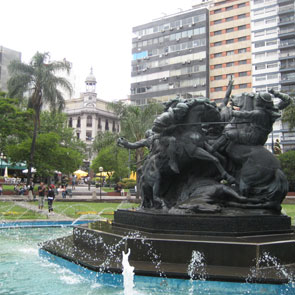Join the UruguayNow mailing list:
UruguayNow in the press
UruguayNow's mix of travel and tourist information on Uruguay, hotel reviews for Montevideo and Punta del Este (coming soon for Colonia), restaurant reviews and tips on excursions, sightseeing and lifestyle in Uruguay has been featured in El Pais, La Republica, MercoPress and on Uruguay's Channel 5 TV and other news media in the country. Internationally, we have had kind mentions in the New York Times and the Daily Telegraph.
Best of the Web
Not yet made it to Uruguay? When you're done with UruguayNow, our choice of the top 6 internet resources for the country is just a mouse click away. In no particular order, they are:
Southern Cone Travel: http://southernconeguidebooks.blogspot.com/
Mercopress: http://en.mercopress.com/
Ola Uruguay: www.olauruguay.com
Retired in Uruguay: http://wallyinuruguay.blogspot.com/
Uruguay Natural: www.uruguaynatural.com
Global Property Guide: http://www.globalpropertyguide.com/Latin-America/Uruguay
For reviews of these sites, please click here.
Other recommended sites

Centre
The Centre of Montevideo is the district to the east of the Plaza Independencia, straddling the Avenida 18 de Julio, the main downtown drag. Plaza Independencia is not the official “point zero" of the city (this honour goes to Plaza Libertad) but it feels as though it should be. On one side is the Palacio Salvo, which was South America’s tallest building when it was unveiled in 1928. It is still a symbol of the Uruguayan capital, as many a postcard will prove, but the washing hanging to dry out of some of the upper units and the occasional broken shutters look a little incongruous.
In the middle of the square is the equestrian statue and tomb (down the steps) of Uruguay’s great patriot, General José Artigas.
The Avenida 18 de Julio (“Dieciocho" to everyone in the city) was, until twenty years ago, Montevideo’s undisputed shopping and entertainment district, with hundreds of stores packed into numerous galerías (arcades) running off it. While many shops and cinemas have decamped to the shopping centres of Pocitos, Punta Carretas and Carrasco, the theatre district has remained. Evangelical churches and slot machines have moved in as rents drop. But the Centre is, and has always been, a popular (if noisy) place to live, with sumptuous apartment blocks lining Plaza del Entrevero and Plaza Libertad, two downtown squares along the spine of 18 de Julio.
You’ll find airline and ferry (to Buenos Aires) offices near the Plaza del Entrevero (sometimes called Plaza Fabini) which has a park with a fountain that is a pleasant place to rest. A block to the east, the eye-catching London-Paris building was an early department store and is crowned with a strange cupula. But many visitors also look down: on Plaza del Entrevero you’ll find the entrance to Montevideo’s most original exhibition space, the “Subte" (from “Subterraneo", meaning Underground).Check out www.subte.org.uy for details of their programming.
Also on the Plaza del Entrevero is the Museo del Gaucho, which is worth a visit. Housed in an extravagant rococo mansion dating from the final years of the nineteenth century – which is as much of a draw as the dozen or so interconnecting rooms of exhibits – the museum displays a range of saddles, swords, silverware, mate gourds and bombillas (often surprisingly elegant drinking straws), plus traditional dress. A range of boleadoras – a kind of three-ball lasso used by Uruguay's indigenous peoples, and adopted by the gauchos – particularly catches the eye. There is also a collection of photos of descendents of the gauchos in the first half of the twentieth century, some of the best taken at the Tacuarembó agricultural fair. The museum, housed with a nominally separate coin museum, is open from Monday to Friday, 10 am to 6 pm.
The Plaza Libertad (another square with more than one name, it's also known as Plaza Cagancha) is just two blocks distant and the venue for the city’s main – and very friendly – crafts market. The Supreme Court is housed in a substantial, suitably sober building on the square’s southern side, backing on to the pretty, sycamore-line calle San José, which has a cluster of restaurants (we review two of them).
Although the main downtown sights are grouped between Plaza Independencia and Plaza Libertad, it is worth seeking out the mysteriously overlooked Mercado de la Abundancia on calle San José at the corner of Lanza. It’s a marvelously atmospheric market hall containing a selection of parrillas (restaurants specializing in barbecued meat dishes) and so a less expensive and quieter version of the Port Market. But the Mercado de la Abundancia is not entirely given over to restaurants: there is also a fishmonger and even a shop selling tango gear. If you are hungry, pull up a stool at El Esquinazo.
Not far away, at calle Yi corner Colonia, you'll find the newly reopened tile museum (Museo del Azulejo), containing 4500 decorated antique tiles from eight different countries. You can visit the museum every day except Mondays from noon to 6 pm.
Back on Dieciocho it’s difficult to miss the towering, red-brick town hall, always referred to as the Intendencia. The justly famous Tristán Narvaja street market, by the way, is in the district of Cordón, fifteen minutes brisk walk from the Intendencia, away from the Centre (see feature, here). Although the market only operates on Sundays, the antique shops lining the street are usually open during the working week.
